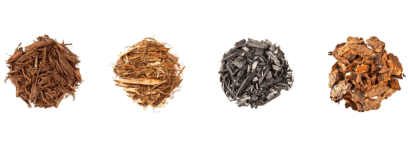What Type Of Mulch Should I Use?

There are 2 main types of mulch: organic and synthetic.
Organic:
-
Natural Wood Mulch is made from different types of wood and continues to decompose adding nutrients to the soil.
-
Cedar mulch is the longest-lasting mulch and doesn’t need replacing as often. It is shredded cedar and the pieces “lock” together soon after spreading in your beds. Our cedar mulch is triple shredded and I’ve seen this product work in beds with no gutters without washing away.
-
Hardwood mulch is composed of any kind of hardwood and is usually a blend of the white wood and the bark. It is less expensive than Cedar but breaks down faster in your flower beds and must be replaced / refreshed more often.
-
Dyed Mulch is usually made from recycled wood – old pallets, decks, crates, etc. that has been dyed. The dye is usually harmless, but these mulches do not enrich the soil like natural mulches do. They break down much slower, requiring nitrogen to do so and in some cases can rob plants of the nitrogen they need.
-
Cypress Mulch is of questionable origin. In the past cypress mulch was a waste wood produced by sawmills and readily available for use as mulch. The reduction of old-growth cypress forests in Louisiana, Florida and throughout the Southeast has made the use of cypress mulch not environmentally friendly.
Pine Straw is readily available in our area.
Pros: It is lighter weight than mulch, can be “gathered” in our area so it is drastically less expensive and lasts longer than other mulches.
Cons: It is not an effective weed barrier since the needles are thin and allow too much light to reach the soil. Because it is so lightweight it is easily blown out of the beds until it has been down for 1-2 years. Insects and rodents can burrow down between the needles easier than with bark mulch or rock. This possibly attracts snakes which can hide easily in the pine straw. Straw is also very flammable.
Gravel / Rocks can also be used as a top-dress.
Pros: They don’t require replacing, so the cost is spread out over a longer period of time. Rock helps prevent weeds better than mulch, are wind resistant and fire-proof.
Cons: They are too hot and raise the soil temperature and radiate heat on your plants causing them to require more water or suffer in the summer months. Some soft leaved shrubs will not perform well (azaleas) due to the heat. It is best to install a landscape fabric when using rock as a top dress also, and this can be problematic for plant health in itself. Eventually, the wind will blow in dirt that will settle between the rocks and some weeds will pop up.
Synthetic: These are man-made materials.
-
Rubber mulch lasts a long time, 10 years plus. It is heavy enough to not blow or float away. It doesn’t attract pests. It is a good insulator and weed barrier.
-
It does cost more and takes several years to recoup your investment. It is flammable since it is an oil-based product usually made from used tires. A landscape fabric should be installed so the rubber mulch won’t get mixed into the soil, the fabric can cause watering issues for plants. It has an odor when it heats up from the sun and can leak small amounts of chemicals into your soil.
There are proponents and naysayers for each type of mulch. It is up to you to choose what best fits your requirements.


